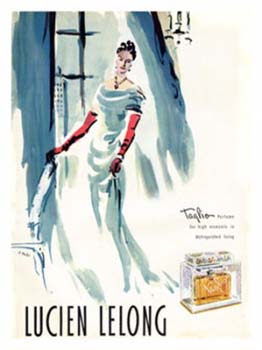Product Description
Lucien Lelong / French Art Deco Handpainted Porcelain Vase circa 1935


LUCIEN LELONG (1889 – 1958) Paris, France
“Metaphysical” vase c. 1935
Hand painted and glazed porcelain with aqua, black and silver tones.
Marks: LL monogram, AB
H: 13 3/4″
Lucien Lelong was born in Paris, France on October 11, 1889. Lucien learned his trade from his father, Arthur Lelong, who owned a textile factory in 1896, and his mother Eleanore, a dressmaker. He discovered his vocation in the family business and as soon as World War I was over, he expanded the family business by creating his own fashion house in the late 1918.
He became immediately famous due to the neat tailoring of his designs and his skill in choosing and manufacturing fabrics. He did not actually create his own designs but hired the most prominent designers of the moment to design his collections such as Christian Dior, Pierre Balmain and Hubert Givenchy. Lelong was one of the first designers to diversify into lingerie and stockings. He introduced a line of ready-to-wear in 1934 which he labeled “editions.” In 1939, Lelong’s collections showed tightly waisted, full skirts; a style which became the “new Look” in Dior’s collection in 1947. After the war, in 1947, Lelong showed pencil-slim dresses; pleated, tiered, harem hemlines; and suits with wasp waists, cutaway fronts and square shoulders.
After a trip to the United States where he learned everything pertaining to the working methods in the mass production of clothes, he returns to France and creates a line of pret-a-porter (ready-to-wear) collection, branded “LL” Edition. Lelong used his double” LL” logo to influence his designs as well as refining the packaging design of his perfumes and cosmetics. He was a master of the use of knits and bias to shape the body in the most complementary way. His house’s trademark was their unique ability in designing with fur.
He was married to Natalie Paley who was the daughter of the Grand Duke Paul of Russia that assisted him with his business. Lelong was an active member of high society; socialized with the women he dressed, and did not miss the opportunity to capitalize on his name. From 1937 until the end of the war in 1948, Lelong was President of the Chambre Syndicale de la Couture Parisienne, in which role he was able to fight and hinder the transfer of the Parisian fashion houses to Berlin during the German occupation. It was largely due to his efforts that ninety-two houses stayed opened during the war.
Poor health caused the end of his career; Lelong retired in 1952, and died in 1958 of a heart attack.
Lucien Lelong / French Art Deco Handpainted Porcelain Vase circa 1935
OLIVIER DE SORRA
SOCIETE FAIENCIERE HERALDIQUE DE PIERREFONDS
Six-branch vase c. 1900
Copper color glaze with blue oxide flower crystallization
H: 11″ x Dia: 9″
Price: $7,250
The Societe Faienciere Heraldique de Pierrefonds pottery studio was founded in the village of Pierrefonds in 1903 by Count Hallez d’Arros and is renowned for it’s crystalline and flambe glazes
